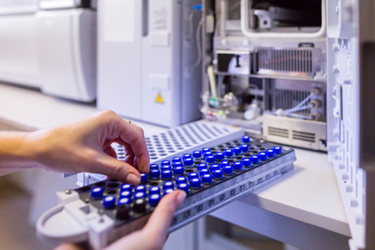USP Unpacks The Evolving HCP Identification And Quantitation Story Behind <1132.1>
By Anthony Blaszczyk and Niomi Peckham, biologics pipeline development, Science-Global Biologics, United States Pharmacopeia

Host cell proteins (HCPs) are unwanted protein impurities derived from the host organism that is used for the production of biotherapeutics. Although rare, residual HCPs can impact both patient safety and product quality.1
The major risks associated with HCPs include:
- unintended immune responses in patients,
- biological activity in patients, and
- impact on the stability of drug product.
Although advances in process development have decreased the number and total concentration of HCPs in the final product, the existence of some HCPs remains inevitable when using standard upstream and downstream purification processes. Because of the potential risk factors, the quantification of HCPs in biopharmaceuticals is considered a critical quality attribute (CQA). Additionally, there is an industry-wide effort to better characterize the type of HCPs being detected (i.e., proteases, glycosidases, lipases, etc.), so that a more accurate risk assessment can be performed on the impact of HCPs on a case-by-case basis. This can be a critical step in drug development because HCP risks can vary based on many factors, including dose amount, route of administration, patient population, dose frequency, etc.
The United States Pharmacopeia (USP) is a non-governmental nonprofit organization that focuses on developing documentary and physical standards and materials to help improve global health. Based on stakeholders’ feedback, including academic and industry leaders, USP General Chapter <1132> Residual Host Cell Protein Measurement in Biopharmaceuticals was published in 2015 in the USP-NF (National Formulary). This chapter focuses on the quantification of HCPs using immunoassays, specifically the assay development and validation approaches needed to show these complex assays and their critical reagents are fit for use. To this day, HCP ELISA (enzyme-linked immunosorbent assay), an immunoassay method described in USP General Chapter <1132>, remains the most common method for the quantification of HCPs. However, the characterization of HCPs by mass spectrometry (MS) is a rapidly evolving technique that is gaining popularity as an orthogonal method that can be used in conjunction with HCP ELISA.
Proposed General Chapter Followed Interest In The MS Approach
Use of MS-based approaches has grown in recent years due to the recognition that some HCPs are not robustly detected by the ELISA method, which relies on sufficient antibodies to measure a single HCP within a large, diverse antigen pool. Analysis by MS allows better quantitation and has the benefit of HCP identification, which allows for a more relevant HCP risk assessment. After stakeholders expressed an interest in the MS approach and a need to align on best past practices, the USP created an expert panel tasked with authoring a chapter on this topic.
Proposed USP General Chapter <1132.1> Residual Host Cell Protein Measurement in Biopharmaceuticals by Mass Spectrometry was published in March 2023 in the Pharmacopeial Forum (PF49(3)) for public comment. This chapter provides both new and experienced MS users with information, guidance, and best practices for HCP LC-MS/MS analysis. The steps in a typical workflow are described, including sample preparation, peptide generation, (U)HPLC methods, MS(/MS) methods, and data analysis. Additionally, best practices for reporting ELISA versus LC-MS/MS (liquid chromatography tandem mass spectrometry) data are discussed to help end users optimize their HCP analysis capabilities. Lastly, key terminology is defined in the chapter to harmonize definitions of commonly used terms in the field. The sections below provide a high-level summary of the topics discussed in USP Chapter <1132.1>.
Let’s Start With Sample Prep
Although mass spectrometry is an extremely useful technique, its sensitivity also makes it prone to buffer/matrix interference. Because of this, sample preparation is a critical step, especially for the analysis of HCPs, which are sometimes present at such low concentrations that additional steps are required to increase detectability. Bottom-up LC-MS/MS is the standard HCP quantitation method. Bottom-up proteomics is defined in USP General Chapter <1132.1> as “the analysis of enzymatically produced peptides and the characterization of their amino acid sequences using LC-MS/MS.” This technique is more appropriate for HCP quantitation compared to a top-down (intact protein) approach, which cannot provide the same level of accuracy.
The most straightforward sample preparation is a standard proteolytic digestion of the entire sample, which includes the drug product and all HCPs. Trypsin is the most common enzyme used due to its high specificity, reliability, and commercial availability. Standard proteolytic digestion typically includes denaturation, reduction, and alkylation. However, alternative methods are required in certain instances to increase the sensitivity of HCP detection. The two main techniques to enhance HCP sensitivity are product protein depletion, whereby extra steps are performed to separate the product from HCPs (i.e., native digest, adsorption onto affinity column, separation by MWCO filter), and HCP enrichment, whereby the relative HCP concentration is enriched (i.e., antibody extraction, affinity reagents, enzymatic activity). Although these techniques can be extremely advantageous, especially when looking for specific HCPs with very low concentrations, quantitation accuracy may be sacrificed due to extra purification enhancement steps.
Choosing Equipment And Workflows
When using MS, there is a range of instrumentation and workflows that can be used for HCP analysis. The choice of instrumentation will depend on the kind of analysis being performed, as well as preexisting information on target HCPs. Nevertheless, most instruments being used for HCP analysis have an ESI (electrospray ionization) source and have the capability to do tandem MS. Several different mass analyzers, including quadrupole time of flight (QTOF) or Orbitrap, can be used for analysis. More information can be found in USP General Chapter <736> Mass Spectrometry. There are two types of MS/MS scan modes that can be used for data acquisition, data-dependent acquisition (DDA), and data-independent acquisition (DIA). The DDA approach selects specific precursor ions, which are subsequently fragmented and further analyzed in the MS2. Alternatively, the DIA method fragments all precursor ions prior to MS2 analysis. For a more detailed description of DDA and DIA, refer to USP General Chapter <1132.1>.
The diverse physicochemical properties of peptides make accurate HCP quantitation challenging while using mass spectrometry. Since each peptide has a different ionization efficiency, fragment ions, and detectability, quantitation of HCPs by mass spectrometry is usually semi-quantitative. Typically, it is accepted to report the data with a plus or minus two-fold accuracy. A brief description of the three most common approaches for HCP quantitation are:
- Relative to Product Protein: A known amount of product, which is digested in the same way as HCPs, is used to quantitate the amount of HCPs by comparing the signal ratios.
- Relative to Spiked-in-Proteins: An intact protein with a known concentration, which is used as a standard, is added to the sample prior to digestion, and the response factor of that protein is used to quantify the HCP peptides.
- Relative to Spiked-in Peptides: Known peptides, which are often stable isotope-labeled, are spiked into samples before or after digestion and used as calibration standards for HCP measurements.
Each of the quantitation methods listed above have their own advantages and disadvantages. A proper evaluation of what technique would be ideal is an important step before initiating HCP quantitation with MS. Additional information about each technique, as well as method validation and system suitability recommendations, can be found in the proposed chapter <1132.1>.
Conclusion
USP is actively working on products that can be used to assist in HCP quantitation. Based on feedback from stakeholders, USP is currently in the process of generating stable isotope-labeled (SIL) peptides for CHO HCPs that have been characterized as high risk and/or high abundance, specifically in mAbs. The SIL peptides can be spiked directly into the sample and used as a calibrant for specific HCPs, as is described in the “Relative to Spiked-in Peptides” description above. We envision these peptides to be a valuable tool that will allow for better assessment and quantitation of HCPs for any laboratory employing LC-MS/MS in HCP quantitation. Additionally, USP recently released recombinant CHO phospholipase B-like 2 protein (PLBL2) (Catalog Number: 1582716) as its first Analytical Reference Material (ARM). This material can be used for the identification and quantitation of PLBL2 HCP during mAb manufacturing.
The ability of LC-MS/MS to be used as an orthogonal approach for HCP analysis allows manufacturers to search for HCPs of concern that could be present at levels not detectable by ELISA. LC-MS/MS does require costly equipment and highly trained analysts to operate the instrument and analyze the complex data. However, the method can still be amenable to QC release testing and, as the field continues to grow, may someday become a common method for HCP quantitation. For additional information about this topic, please access a recent webinar USP held on best practices for HCP measurement by LC-MS/MS.
References
- M. Jones et.al. “High‐risk” host cell proteins (HCPs): A multi‐company collaborative view, Biotechnol. Bioeng. 2021;118:2870–2885.
About the Authors:
 Anthony Blaszczyk is in the Pipeline Development group within USP’s Global Biologics department. At USP, he works with scientific experts and stakeholders to develop new standards to support biopharmaceutical quality assessment and development. Prior to USP, Anthony worked at Catalent Cell and Gene Therapy, where he managed an analytical development team responsible for the development, qualification, and transfer of methods. He obtained his Ph.D. in biochemistry from Penn State University in 2018.
Anthony Blaszczyk is in the Pipeline Development group within USP’s Global Biologics department. At USP, he works with scientific experts and stakeholders to develop new standards to support biopharmaceutical quality assessment and development. Prior to USP, Anthony worked at Catalent Cell and Gene Therapy, where he managed an analytical development team responsible for the development, qualification, and transfer of methods. He obtained his Ph.D. in biochemistry from Penn State University in 2018.
 Niomi Peckham is the director of pipeline development in USP Global Biologics. The pipeline development team works with scientific experts and stakeholders to develop physical and documentary standards used to support the development and quality assessment of biopharmaceuticals. She holds a Master of Science in molecular and cellular biology from SUNY Stony Brook. She has spent most of her career at Pfizer and Alexion Pharmaceuticals, focusing on the analytical development of protein-based biopharmaceuticals.
Niomi Peckham is the director of pipeline development in USP Global Biologics. The pipeline development team works with scientific experts and stakeholders to develop physical and documentary standards used to support the development and quality assessment of biopharmaceuticals. She holds a Master of Science in molecular and cellular biology from SUNY Stony Brook. She has spent most of her career at Pfizer and Alexion Pharmaceuticals, focusing on the analytical development of protein-based biopharmaceuticals.
